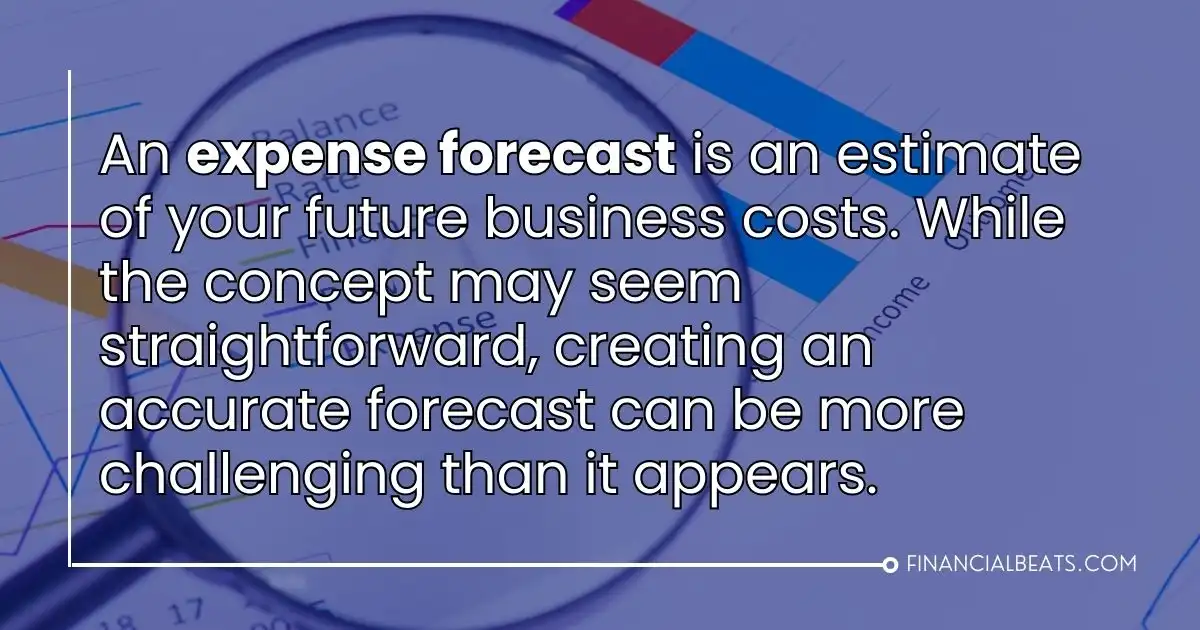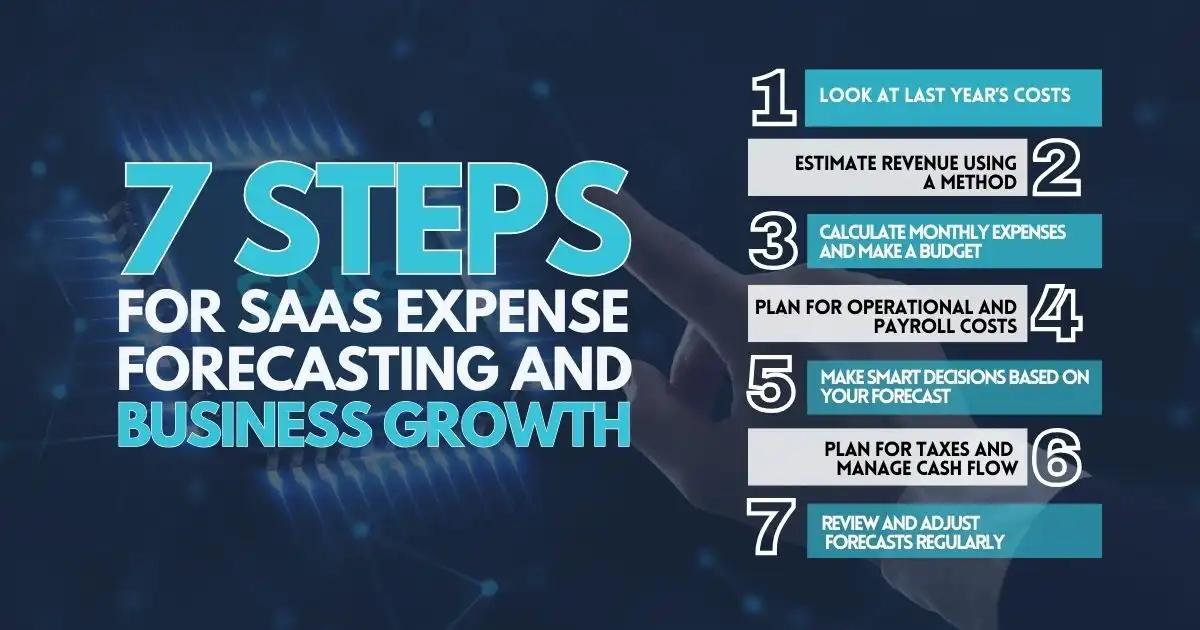How long will your money last?
It’s not just about understanding your current cash flow; it’s about planning for the future and reaching your goals.
Even though business leaders can’t control everything, like changes in the economy or what the market does, they can still manage their spending.
In fact, costs can change quickly, and the market is always moving, so understanding how to plan your expenses is important.
This is where effective SaaS expense forecasting comes in. It allows C- Suite leaders, C- suite executives, and other leaders to see what the company’s finances might look like in the future and make smart plans to help the business grow.
What Is an Expense Forecast and Why It Matters?

An expense forecast is an estimate of your future business costs. While the concept may seem straightforward, creating an accurate forecast can be more challenging than it appears. For any business, especially SaaS startups, having a precise and reliable forecast is important, often referred to as the “burn rate.”
The burn rate shows how long your available funds will last. The goal is to align your expenses with revenue growth and any additional funding, ensuring your business can achieve profitability. Expense forecasts also help pinpoint areas where spending can be reduced, allowing you to manage your cash flow effectively for sustainable growth.
Given the current economic climate, with unpredictable market shifts, expense forecasting is more important than ever. Unfortunately, 90% of startups don’t survive, and even successful ones have had to lay off employees.
Though things may be improving, uncertainty remains. Careful planning, including understanding your burn rate concerning revenue and staffing, can help your startup thrive despite these challenges.
7 Steps for SaaS Expense Forecasting and Business Growth
Expense forecasting helps SaaS companies manage costs and grow. These steps show how to plan budgets, track expenses, and set goals to keep the business on track and prepare for the future.

Step 1. Look at Last Year’s Costs
- Check all your expenses from last year, like rent, salaries, marketing, and software. Use this information to predict future costs.
- Add a small percentage for inflation or business growth to set a basic starting point. You can make this prediction more accurate later.
Step 2. Estimate Revenue Using a Method
To plan your expenses well, you need to predict your revenue:
- Top-down Approach – Leaders set revenue goals for each department based on business growth plans.
- Bottom-up Approach – Department heads create detailed plans based on what their teams can do, aligning with company goals.
Setting realistic revenue targets helps you match your budget with your long-term plans and make adjustments when needed.
Step 3. Calculate Monthly Expenses and Make a Budget
- Estimate your monthly expenses, including marketing, software, utilities, and payroll. Think about costs for new employees too, like salaries and benefits. Divide the costs by department based on your business strategy—some might be growing while others might be shrinking.
- Use this information to create a budget that matches your revenue forecast and helps you manage spending across key areas like marketing and hiring.
Step 4. Plan for Operational and Payroll Costs
- Operational Costs – SaaS companies have costs like salaries, marketing, and hosting. These can be:
- Fixed Costs – Costs that stay the same each month, like rent.
- Variable Costs – Costs that change based on sales, like marketing and travel.
- To estimate variable expenses, start by predicting your revenue. You can use methods like the Sales Capacity Model (based on how many sales reps you need) or the ARR Snowball Method (based on recent revenue trends).
- Payroll Costs – Payroll is a big expense. Estimate the number of employees you’ll need based on your revenue targets. Look at your current staff, including their roles and salaries, and check how many people you might need as your business grows.
Step 5. Make Smart Decisions Based on Your Forecast
- Forecasting helps you see possible future outcomes. Leaders can use this information to make decisions that help the business grow and handle any problems that come up.
- For example, if forecasts show more cash flow, it might be a good time to invest in marketing or new products. If risks show up, taking action early can prevent bigger issues.
Step 6. Plan for Taxes and Manage Cash Flow
- Planning for taxes is important because they are a big expense for businesses. Predict your revenue to know how much to set aside for taxes, so you don’t run into cash flow problems.
- Reviewing your forecasts regularly and comparing them to actual spending helps you stay accurate and adjust your plans to keep finances steady.
Step 7. Review and Adjust Forecasts Regularly
- Forecasting isn’t something you do once; it’s ongoing. Review and update your forecasts every month or quarter to keep them accurate.
- Use what you learn to adjust your budgets and ensure your plans match the current business conditions. This will help you manage costs and prepare for growth and any surprises.
Guide Your SaaS Business with Smart Forecasting
Running a SaaS business is like steering a ship—you need a clear plan to guide you. Forecasting your expenses is that plan. It shows where you are now and helps you reach your goals. Are you checking your expenses closely enough to stay on track?
The market will always have ups and downs, and things can change suddenly. But if you manage your forecasting well, you can control your spending, set revenue goals, and plan for your team. Don’t wait for things to change independently; adjust your plans now.
Will you let the changing market decide your business’s future, or will you use forecasting as your guide to grow and succeed? It’s time to act. Review your numbers, make a plan, and adjust as needed. Turn forecasting into a tool that keeps your business moving forward in the right direction.
FAQs
What is the SaaS Cost of Revenue?
The SaaS cost of revenue refers to the direct expenses a SaaS company incurs to deliver its services. This includes costs like hosting, customer support, and software development that are necessary for running and maintaining the platform. It’s a crucial metric for understanding the profitability of a SaaS business.
How Do You Create a SaaS Cash Flow Forecast?
A SaaS cash flow forecast is an estimate of how money flows in and out of a business over a specific period. To create one, you need to track all income sources, like subscription revenue, and all expenses, including the SaaS cost of revenue. This forecast helps manage finances and ensures there’s enough cash to cover ongoing business operations.
What is an Estimate of Future Revenue and Expenses in SaaS?
An estimate of future revenue and expenses in SaaS involves predicting the income (like subscription fees) and costs (like salaries, hosting, and marketing) the company expects to have over a certain period. This estimate helps in setting budgets, planning for growth, and making informed business decisions.
Why is the Cost of Revenue for a SaaS Company Important?
The cost of revenue for a SaaS company is important because it shows how much the company spends to deliver its services to customers. Understanding this cost helps businesses determine their profit margins and find ways to optimize expenses for better financial health.
